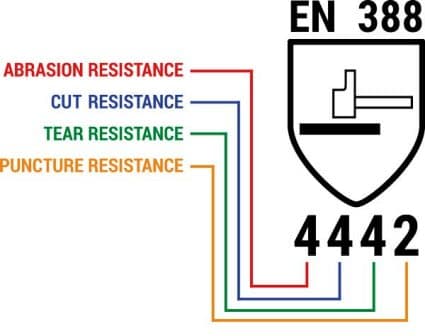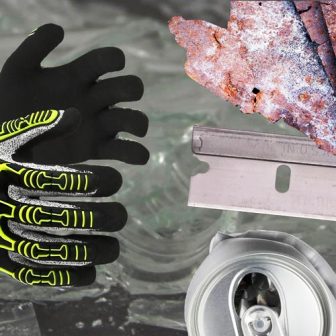Today’s gloves not only do more, but they are also loaded with useful ratings to help you choose the best for your task.
By David Miller
One of the things about my job that I find exhilarating is the challenge of keeping up with new technologies. Nowhere is the landscape changing more rapidly in my field than in the world of protective work gloves. We’re in the midst of a glove revolution—there’s really no other way to describe it. Working hands have never been safer, more comfortable, or more able to do more things with gloves on.
But with any revolution, it’s never neat and orderly. It’s chaos out there in glove land. It’s raining gloves. There are new yarns, new coatings, new construction techniques and thousands of choices. It’s going to take some time for the dust to settle and sort things out.
Mechanical Risks
The best way to deal with a confusing scenario is to “divide and conquer.” Glove users, providers and even the standards setting entities have sought to define the differences between the gloves with meaningful parameters to attempt to sort gloves into categories. Some parameters are self-evident, such as whether a glove is waterproof or not. Some parameters are very subjective, such as whether one glove is more comfortable to wear than another.
There are a number of mechanical risks that can be measured in a glove. We can test and grade gloves for these properties to render a meaningful comparison between them. Mechanical risks are things like abrasion resistance, chemical resistance, insulation from heat, tear resistance, puncture resistance and cut resistance.
Availability of Test Data
In an ideal world, we would have access to all of this information for every glove. In the real world, this is not the case. The availability of test data for mechanical risks depends on the manufacturer’s decision to pay for the testing and to publish the results. This generally happens when the manufacturer wants to publicize how good a glove is against a certain mechanical risk.

We see this most often with gloves that offer cut resistance. This is a big deal because lacerations account for a disproportionate number of hand injuries, and many work situations involve cutting or handling sharp-edged objects. If you are a manufacturer offering a glove that resists cutting, you have a very good incentive to pay for and publish the ANSI cut level of the glove.
While testing is voluntary in the U.S., laws in other places translate into more information being available to us. In the European Union, regulations require that any work glove offered for sale be tested on four separate mechanical risks. The score for each of these risks—abrasion resistance, cut resistance, tear resistance and puncture resistance—appears as a four-digit code on a label that graces every glove sold in the EU. This set of tests is designated by the EN standard 388.
Since many gloves are marketed internationally, we often see this EN388 label on gloves sold in the U.S. It is useful information as long as we understand the code and how it differs from the ANSI standards.
Comparing Cut Levels
The second number on the stamp corresponds to the CEN rating for cut resistance. It rates cut resistance on a scale of 1 to 5; the higher the number, the more resistant it is to cuts. Bearing in mind that all revolutions are messy and chaotic, this 1 to 5 grading system shares the same 1 to 5 scale as the ANSI cut score, but that’s where the similarity ends. The test method uses different machines testing different cutting forces, and an EN388 “5” score is a completely different animal than an ANSI “5”. There have been recent revisions to both the ANSI standard and the CEN standard that will help alleviate this confusion, but it will be a while before the changes to the standard becomes fully implemented in the marketplace.

I will write more on this subject in a future article, but the main point is that ANSI cut scores cannot be fairly compared against EN388 scores to try to determine which glove is more cut resistant.
Puncture Resistance
A similar rookie’s mistake is to assume that the glove with the higher cut level is a better all-around glove, or that it is going to protect the wearer from all kinds of penetration. The dynamic forces that are at work in using a knife or handling the serrated edge of a sheet of metal are not the same forces at work when handling a thorny rose bush or grabbing a garbage bag filled with sharps.
If you are concerned about protection from punctures, the data you are looking for is ANSI’s puncture score, which is based on a test that measures how much pressure is needed to penetrate the glove material with a 1mm steel stylus. Unfortunately, there is not enough interest in this information to encourage glove makers to provide it to their users except in a few isolated cases.
Here is where we can really benefit from having access to the EN388 label mentioned previously, where the fourth digit in the code represents the grade for puncture resistance. The ANSI test for puncture resistance happens to be the same test used for the EN388 test with one important difference: The ANSI scale is 0 to 5 and the EN388 scale is 0 to 4. You can still compare ANSI to CEN by deducting one grade level from the ANSI score, so an ANSI “4” puncture score correlates to an EN388 “3”.
Needle Resistance
For workers who face the danger of accidental needle sticks, even the puncture test will not adequately inform us of a glove’s resistance to penetration of a hypodermic needle. Consider this: the puncture test uses a relatively blunt 1mm stylus; yet a 28-gauge needle is roughly one-third that diameter with a sharpened tip that’s 0.09mm thick. A puncture score won’t help if you are trying to compare gloves to see which will do a better job preventing needle sticks. Human skin, after all, is fairly puncture resistant, yet these needles were devised to deliver their payload with the least resistance to their subcutaneous destination.

ANSI recognizes the seriousness of the threat of needle sticks and has created ASTM F2878 to assess resistance to it. It is not one of the numbers you will find on the EN388 stamp; in fact, you will not find many gloves at all who have undergone testing for needle sticks because there are so few that would be able to boast a good result. However, any glove that is effectively needle resistant will have undergone this testing and will most willingly share the results with the public, because it is a tremendous selling point to be able to show effectiveness in this area.

Approach Your Selection with a Clear Idea of Risks
If you approach your glove selection with a clear idea of the mechanical risks that your staff faces, you can zero in on the gloves that test well for those mechanical risks. Suddenly, the forest of gloves becomes more manageable and you can go from tree to tree to find the glove that best defends against the relevant risks and start to consider other factors such as comfort and price. And keep in mind that your supplier can help you find the gloves that do the job for the best value.
David Miller is the Waste Industry Manager for HUB Industrial Supply (Lake City, FL). He is a Certified Safety Professional and works with managers to effectively implement and manage PPE and MRO programs in the waste industry. He may be reached at [email protected]. HUB Industrial Supply is an Applied MSSSM company.
